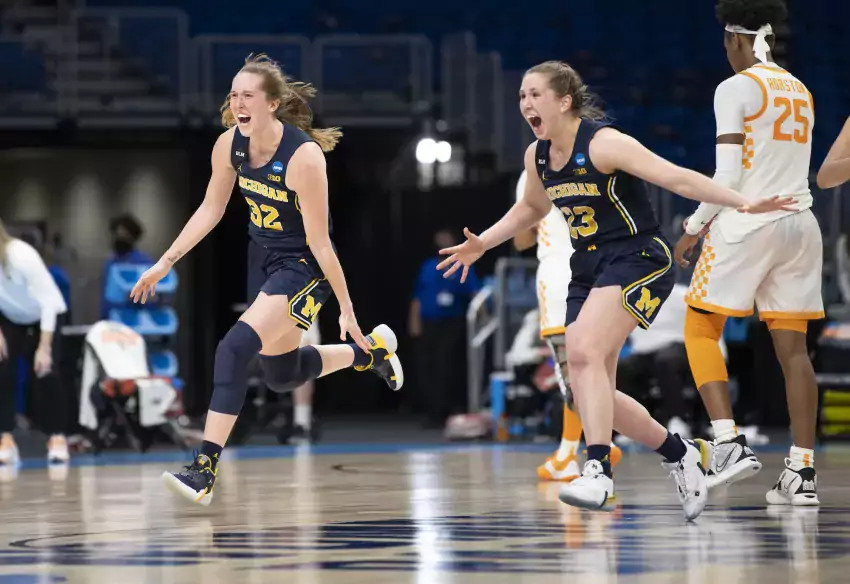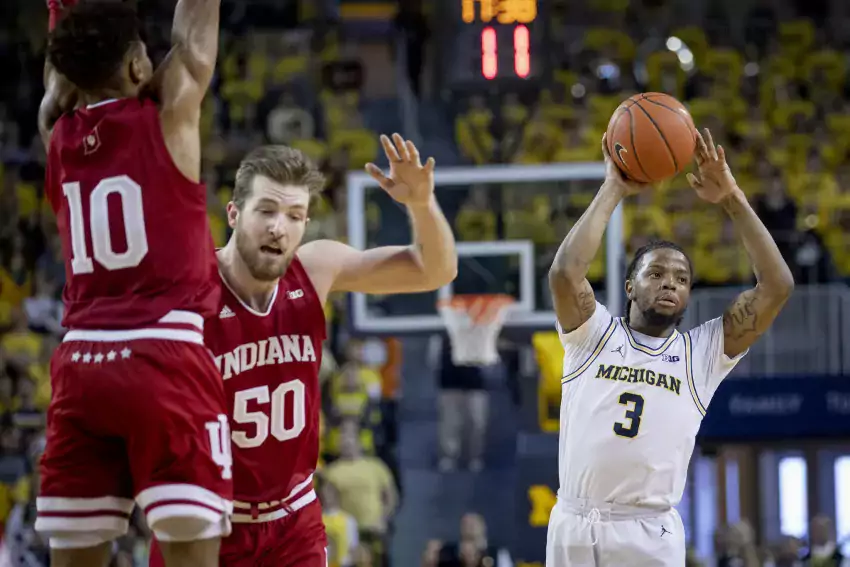akienreh johnson

When I started getting into sports, Tennessee was women's basketball. The legend Pat Summitt coached all-time greats like Chamique Holdsclaw, Tamika Catchings, Kara Lawson, and Candace Parker to three straight national championships from 1996-98, back-to-back titles in 2007 and 2008, and near-annual Final Four appearances in between.
I grew up vaguely aware Michigan had a women's basketball program. The only way to see them was to go to a game in person. Finding someone else interested in watching one of the athletic department's least successful programs was difficult even if one scraped up the motivation to try. They were ignored in favor of football, hockey, men's basketball, softball, baseball, swimming, wrestling—most everything, really.
The three-seed Tennessee team that took the court yesterday wasn't a peak Summitt squad. The uniforms still read "Tennessee"; Kellie Harper, their second-year head coach, was the starting point guard for those back-to-back-to-back champions; they boasted a national player of the year candidate in Rennia Davis, another all-SEC wing in Rae Burrell, and a 6'5 board-crasher and shot-eraser in Tamari Key.
Six-seed Michigan had never made a Sweet Sixteen in program history; they'd reached the second round only five times. Even in the best of years, this is when the Wolverines can't overcome the talent gap.
Good morning! #goblue #ncaaw pic.twitter.com/WEarX80717
— Michigan Women’s Basketball (@umichwbball) March 24, 2021
Good morning.
[Hit THE JUMP.]

Michigan had another successful season under Kim Barnes Arico, going 21-11 (10-8 Big Ten) with a signature win over a ranked Northwestern squad in the Big Ten Tournament quarterfinals. Had there been an NCAA Tournament, the Wolverines would've made it for the third straight year, likely as an eight- or nine-seed.
While that means Michigan's season likely would've ended in the second round on their opponent's home court for the third straight year, this year still felt like progress. Naz Hillmon emerged as a contender for the best player to ever come through the program. When senior Kayla Robbins tore her ACL and her replacement, sophomore Danielle Rauch, also missed time to injury, freshman Maddie Nolan stepped into the starting lineup and the team kept rolling.

the NCAA granted Akienreh Johnson a fifth year [David Wilcomes]
There's a lot of reasons to be excited about the program heading into next year, beginning with how little they lose from this year's roster. Starting guard Akeinreh Johnson, the team's fourth-leading scorer and leader in steals, was granted a fifth year by the NCAA for her injury-shortened freshman year, so the only player currently expected to depart the roster is Robbins, whose injury occurred too late in the season to save her eligibility.
While Robbins was the team's second-leading scorer in the 18 games she played, Michigan got accustomed to life without her, going 9-5 in her absence despite a tough closing stretch that included three games against B1G co-champion Northwestern (M went 1-2).
The Roster Situation
There's no scholarship crunch here despite a lack of departures and four incoming freshmen. The NCAA allows for 15 scholarships for women's basketball teams, two more than the 13 allotted for men's teams. At the moment, Michigan is slated to have 14 scholarship players on the roster.
| Scholarship | 2020-21 | 2021-22 | 2022-23 | 2023-24 |
|---|---|---|---|---|
| 1 | A. Johnson (RS Sr.) | A. Dilk | M. Nolan | M. Fiso |
| 2 | H. Brown (Sr.) | N. Hillmon | M. Sidor | W. Sollom |
| 3 | P. Smeenge (Sr.) | E. Kiser | I. Varejao | E. Stuck |
| 4 | A. Dilk (Jr.) | D. Rauch | M. Fiso | C. Williams |
| 5 | N. Hillmon (Jr.) | M. Nolan | W. Sollom | |
| 6 | E. Kiser (Jr.) | M. Sidor | E. Stuck | |
| 7 | D. Rauch (Jr.) | I. Varejao | C. Williams | |
| 8 | M. Nolan (So.) | M. Fiso | ||
| 9 | M. Sidor (So.) | W. Sollom | ||
| 10 | I. Varejao (So.) | E. Stuck | ||
| 11 | M. Fiso (Fr.) | C. Williams | ||
| 12 | W. Sollom (Fr.) | |||
| 13 | E. Stuck (Fr.) | |||
| 14 | C. Williams (Fr.) | |||
| 15 | (open) |
Barnes Arico can easily open next season with the same starting lineup she used to close this one: senior Hailey Brown and Naz Hillmon in the frontcourt flanked by Nolan, Johnson, and talented junior point guard Amy Dilk. There's some exciting talent from last year's bench and this year's incoming class that could change things up, though.
[Hit THE JUMP for the fresh faces.]

The Defensive Turnaround: Real or Opponent-Driven?
After Brian posted this in the Rutgers game column...
Teske back? Myles Johnson isn't exactly Luka Garza but he is shooting 53% from the floor on decent usage in Big Ten play. Teske shut him off. Johnson was 0/3 and all three of his shots might have been blocked by Teske. Indiana's Trayce Jackson-Davis had as many points (4) in the first three minutes of the Indiana-Minnesota game as he had against Michigan, when he was 2/3 from the floor. IIRC not much of De'ron Davis's game came against Teske.
Tillman did okay personally from two (6/10) but MSU collectively shot 38% from two; OSU shot 44% and Wesson's twos were mostly putbacks or fadeaway jumpers.
Teske's been very rough offensively for the last month but as Michigan's defense surges he seems to be a major part of that. A return game against Trevion Williams up next will be a good measuring stick.
...I took a look at Synergy to see if there were some explanation for Michigan's defensive improvement beyond Teske simply playing better. This led to an entire post's worth of information.
The stats that leap off Michigan's defensive page are their wildly varying abilities against certain sets. They boast a remarkably good pick-and-roll defense but are among the worst power conference programs against isolations and post-ups. Here are the numbers from Synergy for M's defense, with passes included (note: Synergy separates out putbacks from offensive rebounds, so the points per possession figures are lower than you might anticipate):
| % Time | Points Per Possession | Percentile Rank | eFG% | TO% | |
|---|---|---|---|---|---|
| Pick and Rolls | 33.5 | 0.724 | 95 | 39.7 | 12.8 |
| Post-Ups | 10.8 | 0.951 | 17 | 48.3 | 8.1 |
| Isolations | 7.1 | 0.918 | 13 | 48.7 | 9.6 |
The good news: pick-and-rolls are generally better offense than post-ups and isos, so if you have to choose a play to be killer at defending, that's the right one.
After that, I wanted a good visual of Big Ten offenses and their acumen in pick-and-roll and post-up situations. I'm dire at working with anything related to Excel, so thankfully Seth put together some scatter plots for me. My (rather obvious) operating hypothesis was that Michigan would prefer to avoid good post-up teams. Here are the Big Ten's post offenses charted by frequency and efficiency:
_6.png)
Michigan's worst defensive performances have come against these teams almost without exception—the outlier is the first Michigan State game, when the Wolverines couldn't slow down the Winston/Tillman pick-and-roll. Iowa, led by Luka Garza, broke the original scale—Garza is so obscenely good in the paint that the Hawkeyes are more efficient on post-ups than any Big Ten team is on pick-and-rolls. Purdue will, indeed be a big test.
The Wolverines haven't had many of those lately. Indiana is their worst defensive performance by adjusted efficiency since the Jan. 17th loss at Carver-Hawkeye. Their next-worst game in that span: Illinois. Other than Ohio State, which the defense handled relatively well despite the loss, Michigan's recent stretch of good defense has come against teams that generally don't post up often or particularly well—Rutgers checks both boxes.
I'm worried a decent portion of Michigan's recent defensive turnaround is due to the competition. The stretch run will be a challenge. The next three games all come against post-oriented teams: Purdue, Wisconsin, and Ohio State. Then comes a respite against Nebraska before closing the season against Maryland, a very good team but one that Michigan is well-suited to defense.
[Hit THE JUMP for why that's the case, plus a look at the conference's defenses and a preview of Sunday's M/MSU WBB tilt.]
33